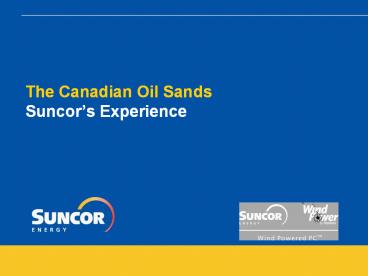The Canadian Oil Sands Suncor - PowerPoint PPT Presentation
1 / 25
Title: The Canadian Oil Sands Suncor
1
The Canadian Oil Sands Suncors Experience
2
Topics
- Overview of Oil Sands Operations how water and
energy are used in the operations - Growing a Sustainable Energy Company Suncors
Experience - Water Governance in Alberta
3
Overview of Oil Sands Operations
4
Suncor Operating Areas
4
5
Oil Sands - the Resource
- Thick, sticky mixture of sand, water and bitumen
- Currently 35 of Canadas oil production growth
projection to 68 by 2010 - Suncor leases cover 1,800 square kilometers or
1,118 square miles - Reserves and resources in place to produce a
potential 14 billion barrels of crude oil
Suncor data includes proved plus probable
reserves and recoverable resources, as of
December 31, 2005 which is not comparable to most
competitors.
6
Oil Sands -
High Quality Leases
6
7
Oil Sands - Mining
8
Steam flows tointerface andcondenses
SAGDIn-situprocess
Steam Chamber
Bitumen Water
Heated bitumenflows to well
9
Water An Essential Resource
- Water is used to convert oil sands into useable
oil products - Hot water separation process
- Transportation medium
- Thermal transfer (heating and cooling)
- Void replacement in reservoir
- Potable and sewage systems
- High degree of recycle, in excess of 75 for
mines, 95 for in-situ - long term retention through water capture in the
void space and deep-well disposal of waste waters - Surface mining uses 3-4 m3 water /m3 oil product,
predominantly from Athabasca River - Closer to 2 m3/m3 for mature plants
- In-situ less than 1 m3/m3 for mature
operations, largely groundwater
10
Water Regional Concerns
- Water Quantity
- Cumulative withdrawal from surface water bodies
- In stream flow needs low flow during winter
period - Water Quality
- Discharge from reclaimed landscape
- Regional Groundwater information not complete
- Potable aquifers
- Deep well disposal
11
Current Net Licensed Water Allocation in the
Athabasca Basin
User of mean annual flow
Existing non-oil sands 0.7
Existing Approved Oil Sands 1.6
Planned Oil Sands 1.3
TOTAL 3.6
12
Energy Inputs in the development of Oil Sands
- Development is energy intensive
- Natural gas heating, steam generation, power
generation - Electricity lighting, pumps, motors, buildings
- Diesel mobile fleet
- Coke by-product is also used as fuel supply
- Co-generation is natural fit Suncor is net
exporter of electricity - Mobile fleet fuels generated on site
13
Energy Efficiency
Outputs Crude Products Electricity By-products
(Coke, Sulphur)
Inputs Bitumen Natural gas Electricity
80 conversion
- Energy efficiency technology, heat integration
key levers to improving performance, reducing
emissions - Intensity measured as energy use per unit of
production is decreasing - 1996 9.9 (gigajoules/m3 production)
- 2000 8.7
- 2004 7.8
14
Growing a Sustainable Energy Company Suncors
Experience
15
Sustainable Development - concept
16
Strategic drivers for sustainable development
- stakeholder expectations(economic,
environmental, social) - shareholder activism
- increased investor interest
- need for integrated view of business strategy
- earning societal consent to operate/grow business
- competitive advantage
17
Suncors vision of sustainability
- Suncors vision is to be a unique and
sustainable energy company, dedicated to vigorous
growth by meeting the changing expectations of
our current and future stakeholders.
18
Putting Suncors vision to workStrategic
framework
Sustainable Energy Company
Environmental Quality
Economic Prosperity
Social Well-Being
Stakeholder Expectations
- Customers
- Shareholders
- Employees
- Communities
- Governments
- General public
Operational Excellence
Products Services for the Future
Issues Management
Improved Decision Making
Stakeholder Relations
Organizational Capability Commitment
19
Water Governance
20
Water for Life Albertas Strategy for
Sustainability
- Finalized in 2003 after extensive public
consultation - Reaffirmed 3 goals and outcomes for Alberta
- safe, secure drinking water
- healthy aquatic ecosystems
- reliable, quality water supplies for sustainable
economy - 3 key directions identified
- knowledge and research
- partnerships
- water conservation
21
Strategic Changes in Water for Life Strategy
- From water management to watershed management
- From traditional regulator to shared
governance/shared responsibility - Water Conservation goal 30 improvement by 2015
(baseline 2005)
22
Watershed Management - Partnerships
- Water Council
- Watershed Planning and Advisory Councils
- 4 Basin Management Plans in development
- 11 councils to be formed
- Watershed Stewardship Groups
23
Multistakeholder Engagement specific to Oil Sands
Region
- Cumulative Environment Management Association
(CEMA) - multi-stakeholder organization responsible for
researching and making recommendations on the
cumulative environmental impact of development in
the Wood Buffalo Region. - Water quantity and quality Watershed integrity
- Reclamation, end-pit-lakes, wetlands
- Regional Aquatic Monitoring Program (RAMP)
- joint environmental monitoring program that
assesses the health of rivers and lakes in the
Oil Sands Region of northeastern Alberta
24
Multistakeholder Engagement specific to Oil Sands
Region
- Wood Buffalo Environment Association (WBEA)
- The mission of the Wood Buffalo Environmental
Association is to monitor and provide accurate,
credible, transparent and understandable
information on environmental quality in the Wood
Buffalo Region - Operates network of air-monitoring stations
- Terrestrial effects monitoring
25
Additional information from
- www.suncor.com
- www.cemaonline.ca
- www.wbea.org
- www.ramp-alberta.org
- www.centreforenergy.com
- www.capp.ca
- www.eub.gov.ab.ca
- www.gov.ab.ca































